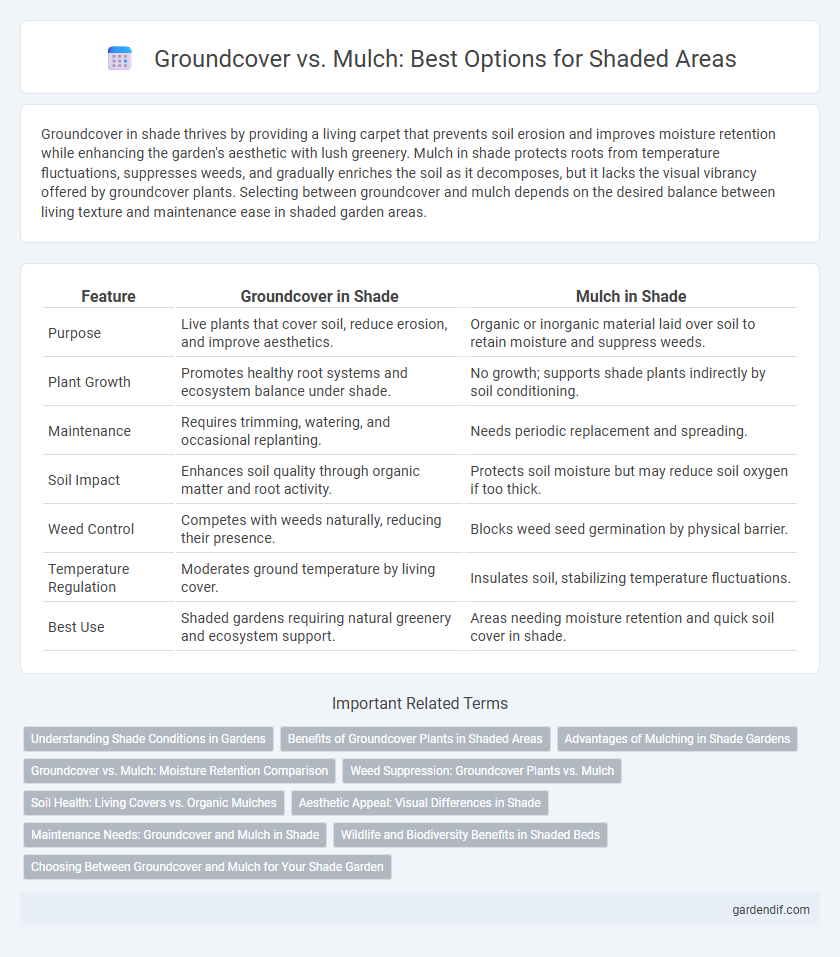
Groundcover in Shade vs Mulch in Shade Illustration
Groundcover in shade thrives by providing a living carpet that prevents soil erosion and improves moisture retention while enhancing the garden's aesthetic with lush greenery. Mulch in shade protects roots from temperature fluctuations, suppresses weeds, and gradually enriches the soil as it decomposes, but it lacks the visual vibrancy offered by groundcover plants. Selecting between groundcover and mulch depends on the desired balance between living texture and maintenance ease in shaded garden areas.
Table of Comparison
| Feature | Groundcover in Shade | Mulch in Shade |
|---|---|---|
| Purpose | Live plants that cover soil, reduce erosion, and improve aesthetics. | Organic or inorganic material laid over soil to retain moisture and suppress weeds. |
| Plant Growth | Promotes healthy root systems and ecosystem balance under shade. | No growth; supports shade plants indirectly by soil conditioning. |
| Maintenance | Requires trimming, watering, and occasional replanting. | Needs periodic replacement and spreading. |
| Soil Impact | Enhances soil quality through organic matter and root activity. | Protects soil moisture but may reduce soil oxygen if too thick. |
| Weed Control | Competes with weeds naturally, reducing their presence. | Blocks weed seed germination by physical barrier. |
| Temperature Regulation | Moderates ground temperature by living cover. | Insulates soil, stabilizing temperature fluctuations. |
| Best Use | Shaded gardens requiring natural greenery and ecosystem support. | Areas needing moisture retention and quick soil cover in shade. |
Understanding Shade Conditions in Gardens
Groundcover in shade provides living protection that stabilizes soil, suppresses weeds, and enhances moisture retention, adapting well to low-light conditions typical in shaded gardens. Mulch in shade primarily conserves soil moisture, moderates temperature, and prevents erosion but lacks the biodiversity benefits that living plants offer. Understanding shade conditions, including light intensity, duration, and soil moisture, is essential for selecting appropriate groundcovers or mulch to maintain healthy garden ecosystems under canopy cover.
Benefits of Groundcover Plants in Shaded Areas
Groundcover plants in shaded areas improve soil structure by reducing erosion and retaining moisture more effectively than mulch. They provide continuous ground protection, support biodiversity by offering habitat for beneficial insects, and enhance landscape aesthetics with live foliage throughout the growing season. Unlike mulch, groundcovers contribute to soil health through root growth and organic matter deposition, promoting long-term ecological balance in shaded environments.
Advantages of Mulching in Shade Gardens
Mulching in shade gardens improves soil moisture retention by reducing evaporation, which is crucial for plants with limited sunlight. It also enhances soil health by gradually decomposing into organic matter, providing essential nutrients for shade-tolerant plants like hostas and ferns. Unlike groundcovers, mulch requires less maintenance and prevents soil erosion effectively while suppressing weed growth in low-light environments.
Groundcover vs. Mulch: Moisture Retention Comparison
Groundcover plants in shaded areas provide superior moisture retention compared to mulch by reducing soil evaporation through living leaf layers. Unlike mulch, which decomposes and requires regular replenishment, dense groundcover maintains consistent soil moisture levels and improves soil structure over time. This living barrier also enhances nutrient cycling, making groundcover a more sustainable choice for moisture management in shade.
Weed Suppression: Groundcover Plants vs. Mulch
Groundcover plants in shaded areas provide effective weed suppression by creating a dense, living barrier that competes for light and nutrients, reducing weed establishment naturally. In contrast, mulch in shade acts as a physical barrier that inhibits weed seed germination but requires regular replenishment to maintain its efficacy. Selecting groundcover species like Pachysandra or Vinca minor enhances long-term weed control with less maintenance compared to organic mulch layers prone to decomposition.
Soil Health: Living Covers vs. Organic Mulches
Groundcover plants in shade environments enhance soil health by maintaining living root systems that improve soil structure, promote microbial activity, and reduce erosion. Organic mulches in shaded areas provide a protective layer that conserves moisture and gradually decomposes, adding nutrients to the soil and supporting beneficial organisms. While groundcovers actively contribute to soil vitality through biological processes, mulches primarily serve as a passive nutrient source and moisture moderator.
Aesthetic Appeal: Visual Differences in Shade
Groundcover in shade offers a lush, textured appearance that can create a vibrant and dynamic landscape beneath trees or in shaded garden areas. Mulch in shade presents a more uniform and muted look, providing a smooth, earthy backdrop that highlights plant foliage without competing visually. The choice between groundcover and mulch in shaded environments significantly influences the garden's aesthetic appeal by balancing color, texture, and visual interest.
Maintenance Needs: Groundcover and Mulch in Shade
Groundcover in shade requires consistent watering and occasional trimming to prevent overgrowth and maintain healthy foliage, promoting natural soil stabilization and moisture retention. Mulch in shade demands regular replenishment every season to sustain its insulating properties and prevent decomposition or displacement by wind and rain. Both groundcover and mulch reduce weed growth effectively, but groundcover offers a living barrier that continuously supports soil ecosystem health, while mulch serves as a temporary protective layer with less ongoing care aside from top-ups.
Wildlife and Biodiversity Benefits in Shaded Beds
Groundcover plants in shaded beds provide essential habitats and foraging opportunities for insects, birds, and small mammals, promoting increased biodiversity compared to mulch alone. Unlike mulch, which primarily offers moisture retention and weed suppression, living groundcovers contribute to soil health by enhancing nutrient cycling and supporting pollinator populations. Incorporating shade-tolerant native groundcovers creates a dynamic ecosystem that fosters wildlife sustainability and ecological balance in shaded garden areas.
Choosing Between Groundcover and Mulch for Your Shade Garden
Groundcover plants in shade gardens provide living soil protection, enhance biodiversity, and suppress weeds while improving soil structure through root systems. Mulch, on the other hand, offers immediate moisture retention, temperature regulation, and organic matter enrichment as it decomposes but lacks the ecological benefits of growing plants. Choosing between shade-tolerant groundcovers like pachysandra or vinca minor and organic mulches such as shredded bark depends on long-term maintenance goals, desired aesthetics, and soil health priorities in shaded environments.
Groundcover in Shade vs Mulch in Shade Infographic

 gardendif.com
gardendif.com